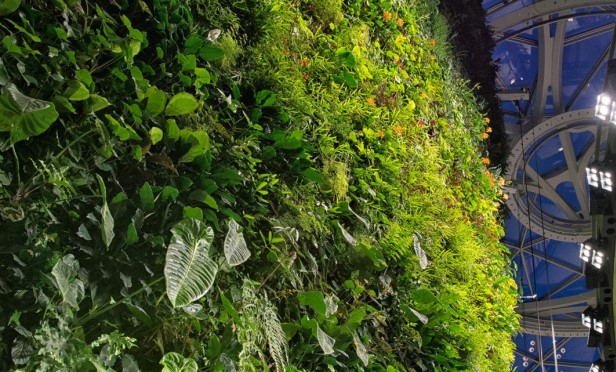 The Spheres is home to more than 40,000 plants in a tropical rainforest/botanical garden setting.
The Spheres is home to more than 40,000 plants in a tropical rainforest/botanical garden setting.
SEATTLE—It's a risk to bet on the suburbs as companies such as Amazon invest in inner-city campuses. Amazon made a conscious choice to invest in downtown Seattle—even though it would have been cheaper to move to the suburbs.
Amazon now employs more than 40,000 tech professionals in Seattle who come from around the world. About 15% of Amazon employees live in the same ZIP code as the office and about 20% walk to work. This is one of the many advantages of having an urban campus.
Earlier this year, Amazon announced the opening of The Spheres, the company's headquarter buildings on 7th Avenue. The project is part of Amazon's more than $4 billion investment in the design, development and construction of this facility.
“Seattle and Bellevue have become one of the country's main tech corridors. Amazon and Microsoft alone are building millions of additional square feet. There are more construction cranes on the horizon in Seattle than ever before,” John Hempelmann, one of the founding partners and the chairman of Cairncross & Hempelmann, tells GlobeSt.com. “The population here is not only highly educated, but also highly wired, so every real estate developer is thinking about technology in every project, whether it's office or commercial or residential or retail or institutional. They're building for a very tech-oriented, highly educated savvy clientele.”
While employees have embraced this urban setting, they have not given up the nature that comes with the suburbs. Studies suggest that spaces that embrace nature can inspire creativity and even improve brain function.
The Spheres is home to more than 40,000 plants from around the world, more like a tropical rainforest/botanical garden than a typical urban office. The Spheres are a result of innovative thinking about the typical workplace and an extended conversation about what is typically missing from urban offices–a direct link to nature.
“Our goal with The Spheres was to create a unique gathering place where employees could collaborate and innovate together, and where the Seattle community could gather to experience biodiversity in the center of the city,” said John Schoettler, Amazon vice president of global real estate and facilities.
Amazon is committed to sharing the beauty and biodiversity of the Spheres with the public, and provides educational opportunities to Seattle community through tours, field trips and partnerships with local schools and universities. The Spheres also include a visitor center called the Understory that is open to the public year round. The Understory provides a fully immersive experience where visitors can get up close and personal with the science, engineering and plants behind the Spheres.
The Spheres have no enclosed offices, conference spaces or desks. Still, the Spheres were built with variety of ways to communicate, work and dine on five different levels with a backdrop of river and waterfall features, a four-story living wall and epiphytic trees. Employees can meet in treehouses suspended under 40-foot trees or in sitting areas and walking paths alongside cascading waterfalls.
Beyond the nature-inspired aesthetics, the construction stats on the Spheres are staggering as well.
More than 600 full-time jobs were created through the design, build and construction of the Spheres. More than 620 tons of steel were used, enough to build the Space Needle three times. There were 12 million pounds of concrete used in the construction, or enough concrete to build a highway from Seattle to Sacramento.
The exterior facade features a naturally occurring shape in nature called a Catalan, and this shape repeats throughout the Spheres with 60 faces per sphere and 180 total. The Spheres' facade contains 2,643 panes of glass that are ultra-clear and energy efficient, with a film interlayer to keep out infrared wavelengths that produce unwanted heat.
Structural engineers tested the Spheres for all kinds of environmental factors, including 91 different scenarios. At the base of the Spheres, a 400,000-pound ring beam transfers heavy loads of gravity, wind and seismic forces from the glass-and-steel facade to columns in the parking garage below.
The largest Sphere is more than 90 feet tall and 130 feet in diameter. All three Spheres share a single indoor environment, which makes air flow critical between the buildings. Radiant floor heating and cooling is an efficient way to balance indoor temperature, and also ensures that less hot and dry air circulates through the HVAC system.
The Sphere's architect was NBBJ and the structural engineer was Magnusson Klemencic Associates.
© 2025 ALM Global, LLC, All Rights Reserved. Request academic re-use from www.copyright.com. All other uses, submit a request to [email protected]. For more information visit Asset & Logo Licensing.








